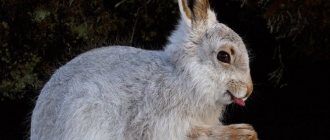Since childhood, we have known what kind of animal this is - a fox. We know what she looks like, we know she is a predator. Besides, of course, we all know that they are cunning. The culprit is cartoons and fairy tales, in which this animal always acts as a negative character. But do you know why the fox was called a fox, and why it is called cunning? If not, today you will find out.
Slide captions:
Slide 1
Topic: “Is the fox really a cunning cheat?” Completed by: Daniil Shchebunyaev, student of grade 3 A, MBOU SO school No. 6, Georgievsk Supervisor: Tishina E. A
Slide 2
Appearance Outwardly, the fox is a medium-sized animal with a graceful body on low legs, an elongated muzzle, pointed ears and a long fluffy tail. Common distinguishing features: dark ears and white tip of the tail. The harsher the climate, the more beautiful the fur. In the southern regions, foxes are yellowish-gray, and there are even completely white, albino ones.
Slide 3
Habitat The fox is one of the most common predatory animals in Russia. It is found almost everywhere: in the southern tundra, forests, steppes, deserts, mountains. Everywhere the fox prefers open areas, groves, copses, hills and ravines.
Slide 4
In hungry years, this red-haired robber deftly steals chickens and ducks from the village at night, and can even kill a kid. When catching black grouse, the fox behaves like a real artist. She pretends to be full and tired, and doesn’t care about birds. When the birds lose their vigilance, the hunter makes several powerful jumps and the bird is caught. Habits
Slide 5
MUSHING is one of the fox's hunting methods. When hunting rodents, the fox usually listens, thanks to its very fine hearing, determines the position of the prey with an accuracy of a centimeter, and then overtakes it with a deft leap. Moreover, the fox is able to determine the exact location of a mouse or vole even under the snow, without seeing it.
Slide 6
Her cunning manifests itself in this way. In the ability to evade pursuit, confusing tracks, abruptly changing the direction of movement and confusing the pursuer. It can smell prey from afar, sneak up unnoticed and deftly grab it. It can wait patiently in ambush at a rabbit hole - you just have to find the hole and determine by the smell whether the owner is home. When escaping pursuit, it can even hide up to its ears in water and wait until the danger has passed. In a hopeless situation, she can pretend to be dead in the hope that the enemy will lose interest in her.
Slide 7
Nevertheless, foxes are sometimes amazingly reckless: they come running to the call of a hunter imitating fox vocal signals; returning to areas where they were heavily hunted in the past; the pursued fox often does not notice safe shelters, etc.
Slide 8
conclusion Having studied the habits of the fox, I came to the conclusion that the fox can really be a cunning cheat. But the question of the fox’s exceptional mental abilities remains open.
Rescue tail
The fox needs such a large and fluffy tail to maneuver and mislead its pursuers. When running at high speed, the change in position of the tail allows the fox to turn very quickly. In fact, it acts as a steering wheel. The fox also uses its tail to adjust its landing when jumping.
The white tip of the tail, which serves as a beacon for pursuit, for example, of hunting dogs, is used by the fox in a deceptive maneuver - first, as if showing them the direction of its movement, and then sharply turning in the other direction.
The tail also warms the fox in particularly severe frosts. The size and length of the fur allows the tail to be used as a warm bedding, as a pillow, and as a blanket.
Source
Why is the fox cunning
Why is the fox called cunning? Some believe that this bad reputation is due to the hunting habits of these animals. The fact is that the fox always sneaks up on its prey very cunningly, it can patiently watch for hours in ambush near a hare's hole, and when potential prey appears in sight, it also very deftly and lightning quickly grabs it with its teeth.
In addition, foxes are excellent at confusing their tracks and evading pursuit by abruptly changing the direction of movement; probably thanks to these skills and habits, the epithet “cunning” has been attached to the fox since ancient times.
Types of foxes, photos and names
There are several main types of foxes in nature, and below we will describe each of them in more detail.
Common fox
She is also the red fox, the most popular and at the same time the largest representative of the fox family. The weight of the common fox reaches up to 10 kg, the body length including the tail is 150 cm. The color of the red fox, although red, can have many different shades depending on the place where the fox lives; a characteristic difference of this type of fox is the presence of a white tip on end of the tail and black ears on top. The common fox lives throughout Europe, Asia, northern Africa, North America, and Australia.
American fox
The American fox lives exclusively on the American continent in the southwestern United States and northern Mexico. It is of medium size: its body length ranges from 37 to 50 cm. The back of this fox species is colored yellowish-gray. A characteristic feature of the American fox is the presence of a black tip on its tail.
Afghan fox
Also known as the Bukhara fox, the Balochistan fox is a relatively small representative of its species, its length does not exceed 0.5 meters, and its weight varies from 1.5 to 3 kg. Among other foxes, the Afghan fox stands out for its large ears, up to 9 cm in height. The fur color of this fox is a rich brownish-gray color. It lives in Afghanistan and neighboring countries. Also found in Egypt, UAE, Turkmenistan.
African fox
The African fox is very similar in appearance to the common fox, the only thing is that it is several times smaller in size. Its total length does not exceed 70-75 cm, and its weight is on average 3.5-3.6 kg. Another difference from the common fox is the presence of longer legs and ears. Lives in many African countries.
Bengal fox
It is also an Indian fox, usually of medium size, with a maximum length of 60 cm. The fur of the Bengal fox is short and smooth, and has a red-brown or sandy-brown color. It lives in India, in the foothills of the Himalayas, Bangladesh, and Nepal.
Steppe fox (corsac fox)
This fox is also very similar to the common fox, but unlike it, it has an even more pointed muzzle, longer legs and wider ears. But they are smaller in size, body length is 0.5-0.6 m, and weight is 4-6 kg. It has a lighter coat color and a dark or dark brown tail tip. The steppe fox lives in many countries, from southeast Europe to Asia, including Iran, Kazakhstan, Mongolia, and Azerbaijan.
sand fox
This type of fox boasts wide ears and equally wide paws, which have special pads that protect the fox from the hot sand with thick fur. The pale brown color of the sand fox also serves as an excellent camouflage against the background of sand and stones where it lives. The dimensions of this fox are average - length is 89-90 cm, weight - 3.5-3.6 kg. The sand fox lives in the deserts of North Africa, from Morocco and Egypt to Somalia.
Tibetan fox
It has a brown or fiery red color on the back, turning into light gray on the sides. This fox lives on the territory of the Tibetan plateau and is also found in India, Nepal and China. Its length is 60-70 cm, weight – up to 5 kg.
fennec
Fenech is notable for the fact that it is the smallest fox in the world, its body length is only 40 cm and its weight is up to 1.5 kg. Despite the smallest size in the fox kingdom, the fennec also has the largest ears among all foxes, their length reaches up to 15 cm. Fennecs, like sand foxes, live in the deserts of North Africa, and their paws also have special protective pads that protect their owners from hot in the sun of the sand there. I have a red color, the tip of their tail is black.
Big-eared fox
Despite the name, its ears are not as large as those of the fennec fox, however, the ears of this fox are disproportionately large and reach 13 cm. The big-eared fox has a gray-yellow color with white, yellow or brown spots. A characteristic feature of this species is the presence of as many as 48 teeth (all other foxes have only 42). This fox lives in Southern and Eastern Africa.
Diving somersault
In winter, foxes hunt small rodents living in burrows under deep snow. Most often, the animal engages in mouseing in the morning or evening, and in cold weather even during the day.
“The fox has a unique hearing. She puts her ear to the ground and listens to where the rodents are moving in their burrows. It can stand motionless for a long time, and then suddenly makes a very long jump, sometimes up to two meters high. It buries its muzzle in the snow and pulls out the rodent. The whole thing does somersaults, they’re very acrobatic,” Pate describes the process.
The fox, unlike other red animals, does not change its bright fur coat to a gray one for the winter. There is also a little trick here. The rodents that the rogue hunts, and its enemies - birds of prey, do not perceive the orange color, but see the predator as gray.
Great patience
The fox is an omnivorous predator. She can eat anything that is smaller than herself in size - both hares and fish or frogs. In addition, it eats some vegetation and insects. But getting lunch in winter is a lot of work, requiring special diligence and patience. For example, a hare meanders through the snow in such a way that few people can track it and catch up with it. But a fox can.
“This is achieved by a good sense of smell. Goes for food, knowing the smell of what she likes and can find. Many animals don’t have the patience, and a fox can walk many kilometers untangling a hare’s loops,” said Elinor Pate, a specialist at the Shushensky Bor National Park.
Red cheaters can also patiently wait for a bird, freezing in one position for many hours. When mating season begins for black grouse and wood grouse, the birds are so engrossed in the process that they notice less danger. Having waited for the right moment, foxes can “take” prey from a low branch or ground in one jump.
Why is the fox called that?
The history of the origin of the name given to foxes does not have any supernatural aspects or consonant names in Latin. By the way, in Latin such mammals have the following name: Vulpes.
As for the origin of the Russian name for this genus of mammals, it is associated with the adjective “fox,” which was previously used to denote a color shade. It meant a yellowish or reddish color. And foxes, as you know, often have a fur color close to orange. It was this factor that influenced the fact that mammals received the name “Foxes” or “Foxes”.
Shedding period
The description of a fox during molting cannot be missed and thrown into the background. At the end of winter, the animal begins to rapidly climb and does not look so attractive. The fur sticks out in clumps, becomes dull, and becomes rough. But by May, the fox again becomes the ideal of beauty, acquiring a summer outfit.
There are also foxes that are not entirely healthy or old, who still shed even in June. Summer skins are not valued by fishermen, as they are practically devoid of undercoat. With the onset of autumn, the fur begins to thicken again, and with the first cold weather, the fox again acquires a thick, warm, shiny coat.
Signs of rabies in a fox
Almost half of rabies infections from wild animals occur through contact with foxes. A sick animal can be identified by its appearance and behavior. Characteristic signs of a carrier of the disease are a protruding tongue, intense salivation, and disheveled fur. The animal may have difficulty focusing its vision, which may result in squinting or blurred vision.
Due to damage to the nervous system, the behavior of the animal also changes: in some cases, the disease becomes the cause of unmotivated aggressive attacks by foxes on animals and people, and sometimes the predator becomes lethargic and unnaturally affectionate, and when you try to stroke it or pick it up, a sudden bite may follow.
Rabies is one of the most dangerous diseases transmitted from animals to humans. If a course of rabies vaccinations is not administered immediately after a bite, death is likely. If you encounter an animal in the forest that behaves unnaturally (it is not afraid of humans, does not run away or hide), you should leave this territory as soon as possible, without making sudden movements and without turning your back to the fox.
Play dead
Foxes can not only freeze in one position for a long time, waiting for a victim, but also pretend to be dead. This technique is used even by those cheats who were taken from nature and kept in captivity.
“We often find bird feathers in fox cages. And we observed the following picture: the fox was pretending to be dead. Lies down and can lie motionless for a long time. And in the cages there are feeders with food. The bird sees a dead fox, flies up to the feeder and the fox grabs the bird,” says Anastasia Kharlamova, senior researcher at the Institute of Cytology and Genetics of the SB RAS.
She added that she observed an adult fox teaching her cubs to play dead in order to lure the bird into a trap.
Red predators dig holes on their own. These are usually simple options with two entrances and corridors leading to a den-apartment. But sometimes there are entire labyrinths, as described by specialists from the Shushensky Bor National Park.
Foxes set up substantial dwellings in the ground only for the period of feeding their offspring. At other times, they prefer to use temporary natural shelters, where they can simply rest or hide from enemies. Usually these are various crevices, hollows at the roots or in fallen trees.
At the same time, foxes are not averse to taking over someone else’s home, as in fairy tales. The easiest thing for them is to drive out the badger. Because of his cleanliness, he cannot return to the house if there was a fox there - he does not like the smell, and the remains of food near the mink. He goes to dig a new hole, and the fox takes possession of another living space.











